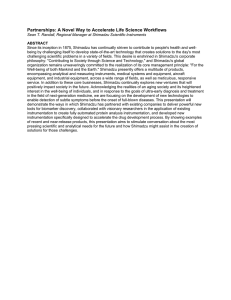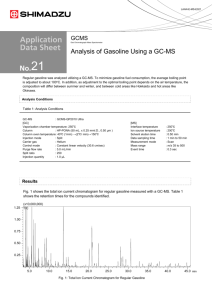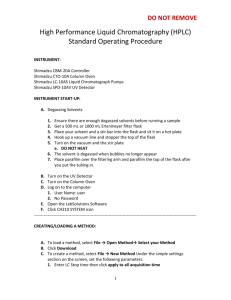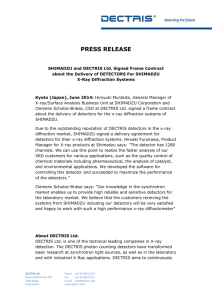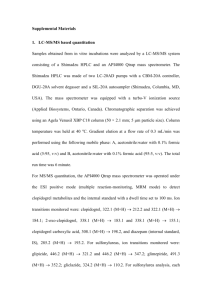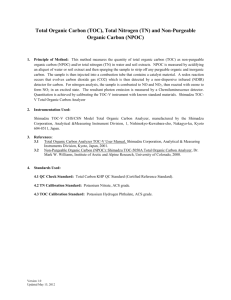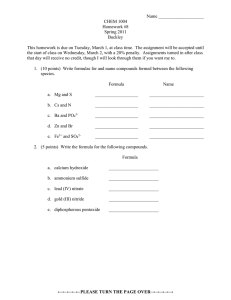Basics of comprehensive GC - Sigma
advertisement
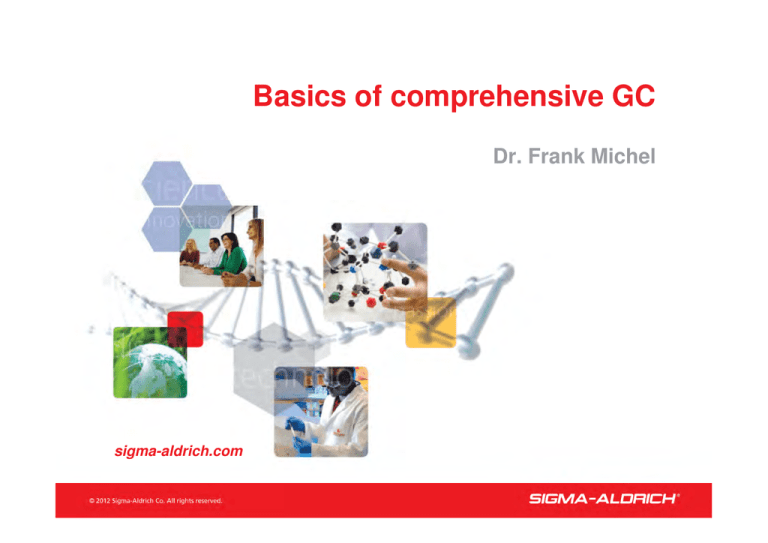
Basics of comprehensive GC •Dr. Frank Michel sigma-aldrich.com Overview •Two-columns-one-MS •Classical Heart-cut •Comprehensive GCxGC •Examples 2 Different Selectivities (37 FAMEs) Omegawax SP-2380 SP-2560 3 Two-columns-one-MS Source: Shimadzu •Cost-efficient option •Saving one MS resp. time for changing •Two columns simultaneously in MS without compromise in performance •Subsequent injections SPB-5 •Either two subsequent data files or one data file is recorded WAX 4 Source: Shimadzu Two-columns-one-MS •Allergenic compounds in cosmetics •Regulation by EU Complete Information and Confirmation •Coelution with matrix by 2. column: H. Leijs et al: J. Agric. Food Chem. 53 (2005),6487 2. Injektion (x100,000,000) TIC SPB-5 2.50 WAX 2.25 2.00 1.75 1.50 1.25 1.00 0.75 0.50 0.25 0.00 5.0 10.0 15.0 20.0 25.0 30.0 35.0 40.0 45.0 50.0 55.0 60.0 5 MDGC/GCMS-2010 Source: Shimadzu Heart-cut 6 Source: Shimadzu Conventional Dean’s Switch Standby Mode Switching pressure 1. Det. 2. Det. Switching pressure 1. Det. Switch Mode 2. Det. 7 Column Switching - Challenges Source: Shimadzu • Switching by valves mechanical system Problem: • Void volume • contact of sample with active surfaces - Absorption • Impacting heating/cooling • Dean switching Pressure system Problem: • Pressure changes Standby(1. Det. ) Cut(1. Det.) Shift of retention times Technical Solution by Shimadzu Source: Shimadzu • Combination of valve (not in anal. line) and Dean switch Multi Dean‘s Switch Technik • Advantages: • No shift of retention time, one master chromatogram sufficient for definition of several cuts • Low void volume because of capillary switching unit • 100 % Recovery Rate • Complete inert unit • Dedicated Software (MDGC Solution) 9 Source: Shimadzu Application – Screening of Allergenes uV(x10,000) 4.25 Chromatogram Allergen standard 4.00 3.75 1 st Dimension 3.50 Allergen standard cuted 3.25 3.00 2.75 2.50 2.25 2.00 1.75 1.50 1.25 1.00 0.75 0.50 0.25 0.00 -0.25 -0.50 -0.75 -1.00 2.5 5.0 7.5 10.0 12.5 15.0 17.5 20.0 22.5 25.0 min 10 Source: Shimadzu Application – Screening of Allergenes uV (x10,000) uV (x10,000) Chromatogram 3.00 Chromatogram 2.1 uV(x10,000) 4.25 Chromatogram 2.0 4.00 2.75 3.75 Allergen standard 1.9 3.50 1.8 1 st Dimension 2.50 Allergen standard cuted 3.25 1.7 3.00 2.25 2.75 1.6 2.50 2.00 1.5 2.25 2.00 1.75 1.4 1.75 1.3 1.50 1.2 1.25 1.50 1.00 1.1 0.75 1.25 1.0 0.50 0.25 1.00 0.9 0.00 0.8 -0.25 0.75 0.7 -0.50 -0.75 0.6 0.50 -1.00 2.5 5.0 7.5 10.0 0.5 0.25 12.5 15.0 17.5 20.0 22.5 25.0 min 0.4 0.3 0.00 0.2 -0.25 8.1 0.1 8.2 8.3 8.4 8.5 8.6 8.7 8.8 8.9 9.0 9.1 9.2 9.3 9.4 9.5 9.6 9.7 9.8 min 18.50 18.75 19.00 19.25 19.50 19.75 20.00 20.25 20.50 20.75 21.00 21.25 21.50 21.75 22.00 22.25 22.50 min 11 Application – Screening of Allergenes Benzyl Alcohol (x10,000,000) TIC 5.5 D-Limonene 2 nd Dimension 6.0 5.0 4.5 Source: Shimadzu 4.0 3.5 3.0 2.5 2.0 1.5 1.0 0.5 6.0 7.0 8.0 9.0 10.0 11.0 12.0 13.0 14.0 15.0 16.0 17.0 18.0 19.0 20.0 21.0 22.0 12 Application – Screening of Allergenes Benzyl Alcohol (x10,000,000) TIC 5.5 D-Limonene 2 nd Dimension 6.0 5.0 4.5 Source: Shimadzu 4.0 3.5 3.0 % 2.5 125.0 2.0 1.5 68 100.0 1.0 0.5 75.0 93 6.0 7.0 8.0 9.0 10.0 11.0 12.0 13.0 14.0 15.0 16.0 17.0 18.0 19.0 20.0 21.0 22.0 50.0 25.0 0.0 41 53 136 107 121 36 148158 173 200 203 225 237 261 268278 295 30 40 50 60 70 80 90 100110120130140150160170180190200210220230240250260270280290300310 13 Application – Screening of Allergenes Benzyl Alcohol (x10,000,000) TIC 5.5 D-Limonene 2 nd Dimension 6.0 5.0 4.5 Source: Shimadzu 4.0 3.5 3.0 % % 2.5 79 100 125.0 2.0 108 90 1.5 80 68 100.0 1.0 70 0.5 60 75.0 93 6.0 7.0 8.0 9.0 10.0 11.0 12.0 13.0 50 14.0 15.0 16.0 17.0 18.0 19.0 20.0 21.0 22.0 40 50.0 30 51 25.0 41 53 136 107 121 20 91 10 0.0 36 148158 173 200 203 225 237 261 268278 295 0 30 40 50 60 70 80 90 100110120130140150160170180190200210220230240250260270280290300310 53 36 121 135 151159 175 194 208 218 236 250 262 278 298 30 40 50 60 70 80 90 100 110 120 130 140 150 160 170 180 190 200 210 220 230 240 250 260 270 280 290 300 310 14 MDGC - Configurations Source: Shimadzu • GC + GC, FID, NPD, ECD, etc. • GC + GCMS • Headspace, Thermal desorption, Pyrolysis, Sniffer, CryoTrap • Each of them can be used as single system, too. 19 Comprehensive Chromatography Source: Shimadzu •Comprehensive Chromatography is an “on-line” multidimensional procedure. •Perment Heart-Cutting allows a 2-dimensional separation of the whole sample. 20 Definition •Giddings Definiton: • A two-dimensional separation can be called comprehensive if – 1. Every part of the sample is subjected to two different separations – 2. Equal percentages (either 100% or lower) of all sample components pass through both columns and eventually reach the detector – 3. The separation (resolution) obtained in the first dimension is essentially maintained. •J.C. Giddings, J. High Resol. Chrom. (10) 1987, 319 21 Comprehensive GC Source: Shimadzu •1991 developed Liu and Phillips a new system for transfer: thermal modulator •Publications of colored 2D chromatogram of an oil sample* initiated interest in GCxGC • *Z. Y. Liu, J. B. Phillips, J. Chrom. Sci. 29 (1991) 227 22 Comprehensive GCMS Source: Shimadzu Thermal Modulation: 23 Comprehensive GCxGC Source: Shimadzu Shimadzu GCMS with ZX-1 Modulator Shimadzu GCMS with ZX-2 Modulator 24 Source: Shimadzu GCxGC - Schematically Detector Injector ZOEX Loop Modulator (cold/hot) nonpolar 30m, 0.25mm, 0.25µ µm First column Second column polar, 1m, 0.1mm, 0.1µ µm 25 Source: Shimadzu Thermal Modulation ZOEX LOOP MODULATOR Capillary column in a loop Cold gas stream Hot gas stream Release of sample molecules Molecules from sample are frozen/focussed 26 Principle – Comprehensive GC No switching unit close to the columns Provides extremely narrow peaks Typical modulated Peak Loop Modulator 1st Stage 2nd Stage Hot Jet Cold Jet ~ 300 ms 27 Source: Prof. Oliver Schmitz Principle – GCxGC 100 % Dimethylpolysiloxane or 5 % Phenyl-95 % Dimethylpolysiloxane 35 – 50 % Phenyl-65 – 50 % Dimethylpolysiloxane, Polyethyleneglycol (Carbowax) or Cyanopropyl-phenyldimethylpolysiloxane hot nonpolar cold polar 28 Source: Prof. Oliver Schmitz Principle – GCxGC hot nonpolar cold polar 29 Source: Prof. Oliver Schmitz Principle – GCxGC cold hot nonpolar cold polar 30 Source: Prof. Oliver Schmitz Principle – GCxGC hot cold nonpolar hot polar 31 Source: Prof. Oliver Schmitz Principle – GCxGC cold hot nonpolar cold polar 32 Source: Prof. Oliver Schmitz Principle – GCxGC hot 4s cold nonpolar hot polar 33 Source: Prof. Oliver Schmitz Principle – GCxGC cold 4s hot nonpolar cold polar 34 Source: Prof. Oliver Schmitz Principle – GCxGC hot 4s 4s cold nonpolar hot polar 35 Source: Prof. Oliver Schmitz Principle – GCxGC cold 4s 4s hot nonpolar cold polar 36 Source: Prof. Oliver Schmitz Principle – GCxGC hot 4s 4s cold nonpolar 4s hot polar 37 Source: Prof. Oliver Schmitz Principle – GCxGC cold 4s 4s hot nonpolar 4s 4s cold polar 38 Source: Prof. Oliver Schmitz Principle – GCxGC 4s 4s 4s 4s 39 Principle – GCxGC Source: Prof. Oliver Schmitz 40 Principle – GCxGC Source: Prof. Oliver Schmitz 4s 41 GCxGC Visulization Stat. Phase Type 1 Boiling point 54.1 min. Stat. Phase Type 50 Polarity Source: Shimadzu 87.5 min. 42 GCxGC Visulization Stat. Phase Type 1 Boiling point 54.1 min. Stat. Phase Type 50 Polarity Source: Shimadzu 87.5 min. 43 Source: Shimadzu GCxGC Visulization GC x GC: Stat. Phase Type 50 Polarity Stat. Phase Type 1 Boiling point 44 GCxGC Typical Example Source: Shimadzu >500 Peaks ! 67 Peaks 45 paraffins & isoparaffins Source: Shimadzu mononapthenes n-C13 Light Crude Oil Fraction diaromatics binapthenes n-C12 monoaromatics n-C11 n-C10 n-C9 n-C8 napthalene methylenechloride methylnapthalenes sulfides benzothiophenes 46 Source: Shimadzu Comprehensive qGCMS of Grapefruit extract Expansion 1D – 45/50 min 2D – 1.5/3.5 sec 47 Source: Shimadzu Comprehensive qGCMS of Grapefruit extract Expansion 1D – 45/50 min 2D – 1.5/3.5 sec 48 Zeit [s] Coffee flavor 5 Cooperation with FH Lemgo Source: Shimadzu Detection of >1000 Components 4 3 2 1 49 13 25 38 50 63 75 Zeit [min] Peak Distribution in second dimension Source: Prof. Oliver Schmitz SLB-5ms + ZB 50 SLB-5ms + SLB-IL 61 51 Comparison: Zebron ZB 50 or SLB-IL61 in second dimension: Herba Menthae Haplocalyx Better Separation 1-Phenylpropanone o-/m-/pMethylacetophenone New Analytes 1-Phenylpropanone o-/m-/pMethylacetophenone Menthone isomer Menthone Isopulegol ? α-Terpineol Isopulegol ? Citronellal Source: Prof. Oliver Schmitz trans-/ cisIsopulegon Borneol Menthol ? Menthone isomer Menthone α-Terpineol Isopulegol ? Menthol isomer Menthol ? Menthol ? Octanoic acid Zebron ZB 50 Menthol isomer Citronellal Lavandulol Menthol ? SLB-IL61 Isopulegol ? 52 Source: Shimadzu Maximizing Efficiency (x1,000,000) TIC 7.0 Classical Gas Chromatography: 6.0 5.0 N = Number of Peaks 4.0 3.0 2.0 1.0 5.0 MDGC/Heartcut: 7.5 10.0 Transfer and separation of single peaks onto a second column. N = N1+ N2 (x1,000,000) 12.5 15.0 17.5 (x10,000,000) 1.0 TIC TIC 7.0 0.9 0.8 6.0 0.7 5.0 0.6 4.0 0.5 3.0 0.4 2.0 0.3 0.2 1.0 0.1 5.0 7.5 10.0 12.5 15.0 17.5 6.0 6.5 7.0 7.5 8.0 8.5 9.0 9.5 10.0 10.5 Comprehensive GCxGC: Continuous „Injection" – all components run on both columns, retention times on both columns are known N = N1 x N2 x cos β (Orthogonalitätsfaktor) 53 Dziękuję za uwagę! •Dr. Stephan Schröder (Shimadzu Deutschland GmbH) •Prof. Oliver Schmitz (University Duisburg-Essen) 54
